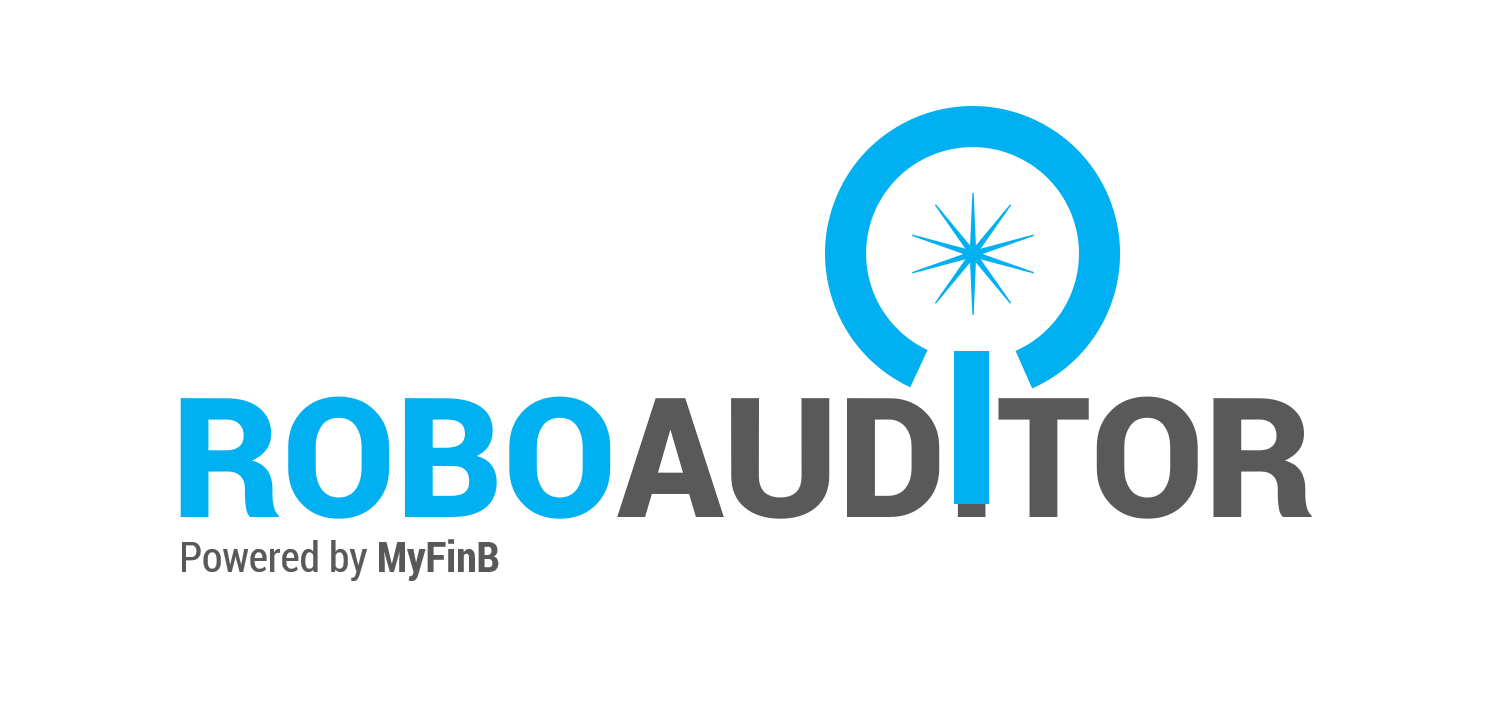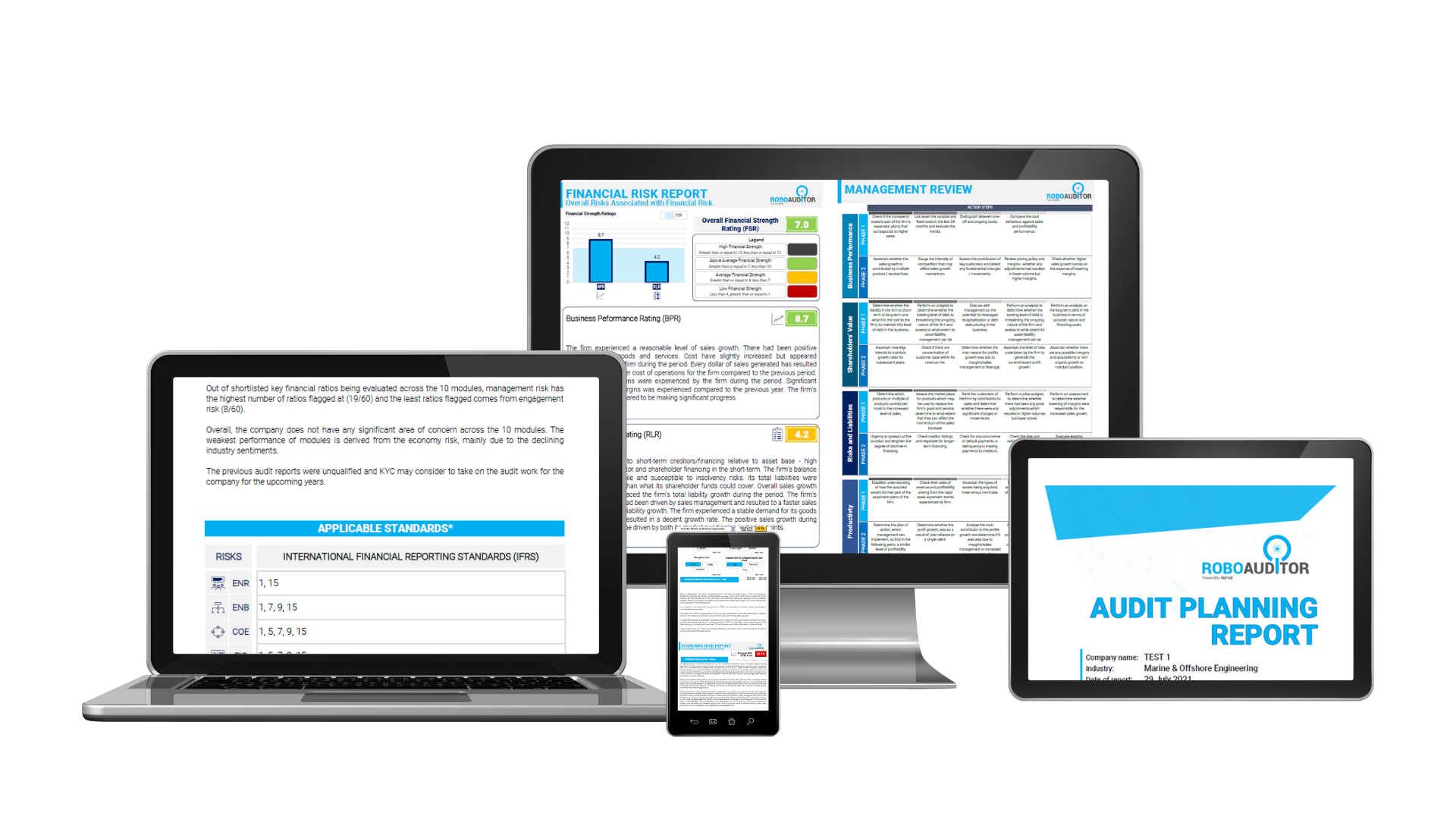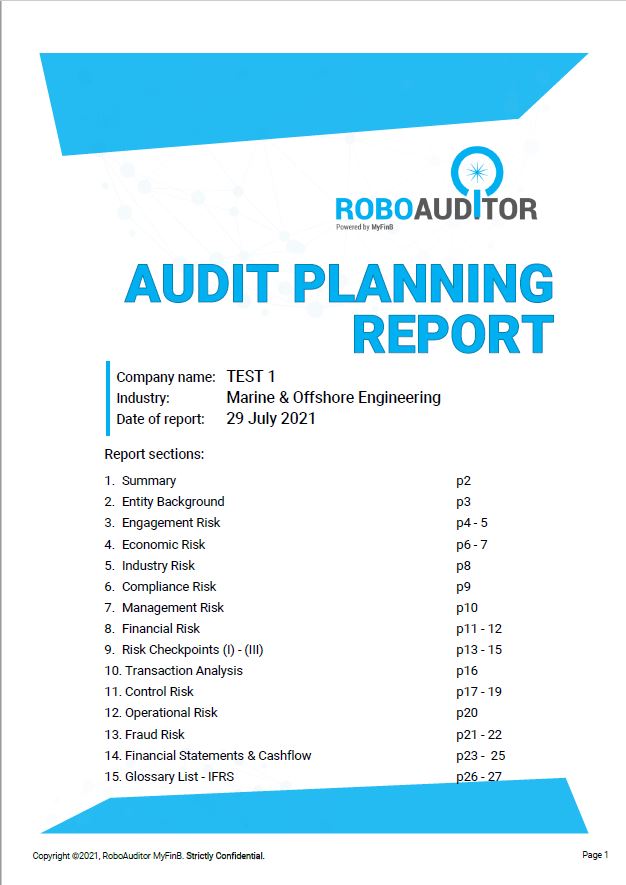Featured
Strategic Approach For Audit Planning Using AI
Reduces human error and ultimately improves the quality of the audit planning process.
Introducing RoboAuditor

RoboAuditor is an AI-based platform for audit risk assessment aimed at assisting external auditors in their audit planning. The system eliminates the key pain point of most small-medium practitioners (SMPs) which is manual approach of assessing audit risks and audit programs.

RoboAuditor is the world’s first AI-powered platform for small and medium practitioners (SMPs).
It is an expert system focusing on reduction of turnaround time, higher margins and positive outcome for auditors. RoboAuditor is a preliminary risk intervention for auditing system which relies on artificial intelligence to evaluate a company in a 360-degree manner. Auditors can confidently rely on this risk-based system for a more efficient and accurate audit program.

Make the audit process more insightful and more efficient
Audit is a data-driven service and shifting repetitive tasks to RoboAuditor frees up time and eliminates accounting errors. By applying technology like RoboAuditor in auditing, the audit professionals can analyse massive volumes of financial data and detect irregularities. Auditors will benefit from increased speed and efficiency, while adding more value to the audit process.
RoboAuditor's potential is illustrated in its predictive value
That is through its ability to review and analyse historical data and make predictions of likely future risks and events. The RoboAuditor will further enrich audit evidence by identifying related concepts or topics, recognizing entities, extracting and understanding subject-action-object relationships.

Powered by 10 Modules
The RoboAuditor platform is powered by 10 modules which are built with descriptive, diagnostic, predictive and prescriptive engines that are powered by natural language generation/understanding (NLGU), cognitive analytics and machine learning systems. RoboAuditor assesses 10 key area of risks within a company.

I. ENGAGEMENT RISK
Engagement risk module covers three key areas namely client’s business risk, audit risk and auditor’s business risk. The system could help identify and profile the risk levels inherent in business performance reporting (client business risk), compliance costs and resources competency (audit risk) and auditors professional liability risk (auditor’s business risk). The system will then diagnose the possible root causes of why such risks exist and predict potential scenarios arising from high initial engagement risk, before engaging the client. The auditors will also be given some recommendations on how to tackle each issue in accordance with the level of risks associated with each variable in this section.

II. ENTITY BACKGROUND
Entity background module involves the process of performing due diligence on company level and individual (key personnel) level. The system could potentially profile the risk levels associated with discrepancies arising in the backgrounds of the company or key personnel. It will also diagnose the possible root causes of why the discrepancies were uncovered and predict the probability of events occurring from such risks. The auditors will also be given some recommendations on how to plan their audit work and deal with the inconsistency of information regarding the client, as highlighted by the system.

III. CONTROL ENVIRONMENT
Control environment module covers how important client’s organisation regards internal control system. The system could help identify and profile the risks associated with the client’s core policies and internal control gap in the perspective of performance measurement, ethnical compliance and accountability of management personal. It also provides potential reasons why such risks exist and predict the likelihood of such scenarios occurring. The auditors will also be given some system recommendations, including process improvement map toward closure of internal control weaknesses highlighted by the system.

IV. FINANCIAL STATEMENT RISK / RISK OF MATERIAL MISSTATEMENT
Financial statement risk/ Risk of Material Misstatement module covers the issue of material misstatements in the financial statements. The system could help identify and profile risks inherent in the going concern assumption, especially for enterprise’s mismatch short term liabilities to fund long term asset acquisition, and operation with recurrence negative free cash flow. It also provides potential reasons why such risks exist and predict the likelihood of events occurring from such risks. The auditors will also be given some recommendations on how to plan their audit work and deal with misstatement risk due to under qualified finance personal or pressure from top management to meet targets, as highlighted by the system.

V. INDUSTRY RISK
Industry risk module covers the risks associated with 3 main factors: price, government regulations and competition, which are particular to an industry group and can potentially drag down the industry’s overall performance. The system could help identify and profile the risks (i.e. controllable, non-controllable) within the industry in which client operates which may include volatility of prices, stringent government regulations and intensity of competition. It also provides potential reasons why such risks exist and makes predictions on the likelihood of events occurring in the presence of such risks. The auditors will also be given some recommendations on how to plan their audit work and evaluate the extent of competition within the client’s industry, the price fluctuations and the government regulations, as highlighted by the system.

VI. ECONOMIC RISK
Economic risk module evaluates how macroeconomic conditions can affect a company’s performance in 3 key areas: demand, costs, and foreign asset and liabilities valuation. The system could help identify and profile the potential FOREX risks and interest risk impact to cost of goods sold, and consequently volatility of prices, and foreign asset and liabilities valuation impact. It also provides potential reasons why such risks exist and predict the probability of events occurring if such risks are to occur. The auditors will also be given some recommendations on how to plan their audit work and ascertain the impact of an adverse economic climate to the client, as highlighted by the system.

VII. COMPLIANCE RISK/INTEGRITY RISK
Compliance risk module relates to how companies abide to The Registrar of Companies regulatory guidelines, reporting guidelines required by central bank, Accounting Regulatory bodies, etc. The system could potentially profile the risk levels associated with not abiding by the required regulations. With the inputs of the auditor, the system will ascertain, in both cases of client and auditor, if any contracts were breached in the past and if the organisations meet the regulatory standards of the authorities mentioned above. The system will then diagnose the possible root causes of why the auditor or the client were not compliant to the requirements stated by regulatory bodies. It also provides potential reasons why such risks exist and predict the probability of events occurring from such risks. The auditors will also be given some recommendations on how to plan their audit work and deal with the issues such as oversight or non-compliance to regulations, as highlighted by the system.

VIII. DIRECTOR/KEY MANAGEMENT RISK
Directors/ Key management risk entails two risks i.e. the lack of associated integrity policy enforcement risks, and lack execution of internal quality control measures and exception reporting. The system could help identify the risk type and profile the risks arising from the negligence or oversight of top management and provide possible reasons why such risks occur. It will also predict the likelihood of event occurring from such risks. Auditors will also be given some recommendations on how to effectively plan their audit work and establish check list against the two risk factors i.e. policy risk and execution risk.

IX. FRAUD RISK
Fraud risk is associated with the act of misconduct of an employee or employees within a company and / or possible collaboration with 3rd party while evading detection. The system could help identify potential weaknesses inherent in the organization’s control and governance. Risks could arise whereby the client’s business-related data and documents integrity are compromised due to possible poor control system, resources competency and lack of segregation of duties within the eco-system. The system will determine possible gaps and provide possible explanations to why fraud related risk could arise. The system will also predict the audit outcome if such scenarios occur. The system will also advise and recommend auditors on how to overcome such deficiencies to ensure the compliance to internal control requirement and regulations override the need to meet KPIs.

X. OPERATIONAL RISK
Operational risk module entails the potential losses resulting from inadequate or failed policies or lack of end to end seamless procedures to prevent leakage. The system could help identify and profile risks inherent in the organisation’s operations function such as work flow execution and communication gap; efficient KPI reporting system, and exception closed loop system. It also provides possible reasons why such risks are present and predicts the possibility of events occurring due to such risks. The system will also provide auditors with advice on how to establish whether client operations are efficient.
A Decisioning System: RPA-AI Development
cognitive and heuristics
(Experience of experts)
accounting and audit standards
industry and country risk information
Risk scoring models
(Default/bankruptcy data)
financial benchmarks
(Industries and sectors over a long period of time)
Neural network codes and principles
scenario modelling techniques
(What-if analysis and predictive models)

